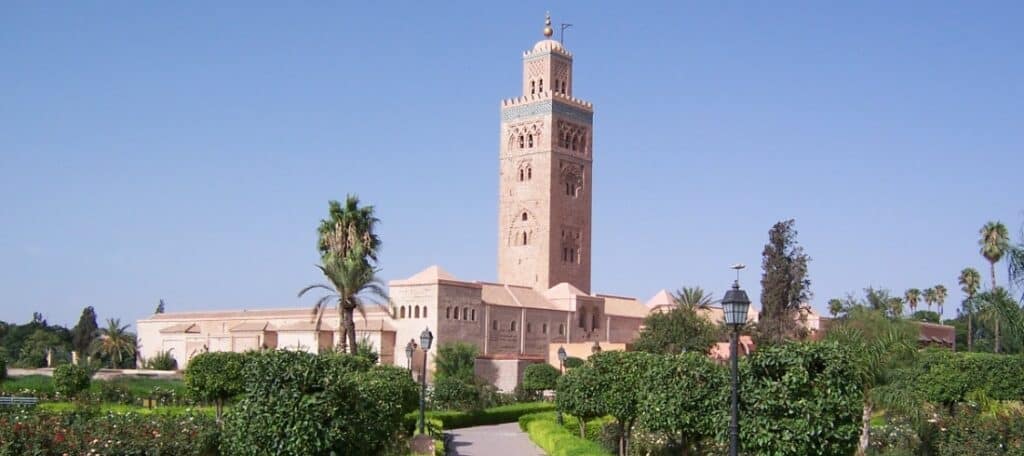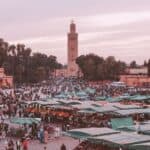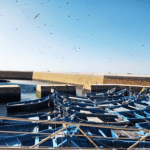
The Koutoubia Mosque, also known as the Kutubiyya Mosque, is a true gem of Marrakech, Morocco. This magnificent mosque, founded in 1147 by the Almohad caliph Abd al-Mu’min, stands as the largest mosque in the city. With its stunning Almohad architecture and iconic minaret, the Koutoubia Mosque is a must-visit for tourists and a source of pride for the local community.
- Impressive Almohad architecture showcased in the Koutoubia Mosque
- The mosque’s majestic minaret serves as a symbol of Marrakech
- Significant religious and cultural importance to the people of Marrakech
- Inspired the design of famous landmarks in Morocco and beyond
- Offers a captivating experience of Islamic architecture and history
History and Architecture of the Koutoubia Mosque
The Koutoubia Mosque, one of the most iconic landmarks in Marrakech, showcases the splendor of Almohad architecture and Moroccan mosque architecture. Designed by the renowned architect Abu Yusuf Yaqub al-Mansur, this magnificent mosque stands as a testament to the rich cultural heritage of Morocco.
Constructed using red sandstone, the Koutoubia Mosque seamlessly blends Islamic and Andalusian architectural styles. Its architectural features, including the square-shaped minaret, are a visual delight. The minaret, reaching a height of 77 meters, is adorned with intricately designed scalloped keystone arches and jagged merlon crenelations.
It is interesting to note that the design of the Koutoubia minaret has served as a prototype for other famous landmarks around the world. The Giralda in Seville, Spain, and Le Tour Hassan in Rabat, the capital of Morocco, draw inspiration from the exquisite design of the Koutoubia minaret.
“The Koutoubia Mosque stands as a masterpiece of Almohad architecture, showcasing the skilled craftsmanship and artistic vision of its builders.”
The minaret itself holds tremendous significance, not only as a symbol of religious devotion, but also as a beacon guiding both locals and visitors to the spiritual heart of Marrakech. The architectural grandeur of the Koutoubia Mosque is a testament to the everlasting allure of Moroccan mosque architecture.
Importance of the Koutoubia Mosque to Marrakech
The Koutoubia Mosque holds great significance for the people of Marrakech. It stands as a testament to the city’s rich history and culture, serving as a symbol of pride and identity. The mosque attracts tourists from around the world with its grandeur and beauty, offering a glimpse into Morocco’s architectural heritage.
“The Koutoubia Mosque is not just a religious site, but a true representation of Marrakech’s past and present, weaving together the threads of history, culture, and spirituality,” says Ahmed, a local historian.
This magnificent mosque is a must-visit tourist destination for those seeking to immerse themselves in the vibrant tapestry of Marrakech. Its towering minaret, visible from various parts of the city, acts as a guiding beacon, drawing visitors closer to its awe-inspiring presence.
- Visitors can marvel at the Koutoubia Mosque’s intricate architecture and marvelously preserved details. From the ornate geometric patterns to the exquisite calligraphy adorning the walls, every element tells a story of Marrakech’s artistic and cultural heritage.
- The mosque’s serene ambiance and meticulously designed prayer halls offer a tranquil space for worshippers and visitors alike. It is common to see locals and tourists taking a moment of reflection or engaging in quiet meditation within the mosque’s peaceful courtyard.
- The Koutoubia Mosque is not just a religious site; it is also a hub of knowledge and learning. Its library houses a vast collection of books on Islamic studies, providing scholars and students with a valuable resource for expanding their understanding of the religion.
Undoubtedly, the Koutoubia Mosque’s role as a religious site is of paramount importance to the local Muslim community. It is a place where the faithful come together to offer daily prayers and participate in special ceremonies throughout the year.
Marrakech: A City of Spiritual Significance
The significance of the Koutoubia Mosque reaches beyond its individual walls. It reflects the broader cultural fabric of Marrakech and its historical ties to Islam. The city’s history and culture are deeply rooted in Islam, and the mosque’s presence solidifies Marrakech as a spiritual center for locals and visitors alike.
The Koutoubia Mosque is a testament to the enduring strength of Marrakech’s religious heritage. Its grandeur, cultural significance, and role as a religious site establish it as an indispensable part of the city’s identity.
| Key Points | Details |
|---|---|
| Tourist Attraction | The mosque’s architectural magnificence attracts tourists from around the world, contributing to Marrakech’s status as a popular tourist destination. |
| Cultural Significance | The mosque symbolizes Marrakech’s rich history and cultural heritage, showcasing the city’s deep connection to Islamic art and architecture. |
| Religious Site | The Koutoubia Mosque serves as an important place of worship for the local Muslim community, hosting daily prayers and special ceremonies throughout the year. |
| Center of Learning | With its library offering a collection of Islamic books, the mosque serves as a center for knowledge and education. |
The Koutoubia Mosque in Marrakech is a testament to the beauty and grandeur of Islamic architecture. As the largest mosque in the city, it stands as a symbol of Morocco’s rich heritage and serves as a prominent landmark for locals and tourists alike. The mosque’s grand minaret, reaching a height of 77 meters, is an awe-inspiring masterpiece adorned with intricate geometric arch motifs.
Not only is the Koutoubia Mosque visually stunning, but it also holds historical and cultural significance. Its design, influenced by Islamic and Andalusian architectural styles, has served as a prototype for other famous landmarks both within Morocco and beyond. The mosque’s connection to renowned architect Abu Yusuf Yaqub al-Mansur further adds to its architectural significance.
For visitors to Marrakech, a visit to the Koutoubia Mosque is a must. Whether one is admiring its beauty from afar or exploring its rich history up close, the mosque offers a captivating experience. It is a cherished site for the local community and a popular destination for tourists seeking to immerse themselves in Moroccan culture and appreciate the enduring allure of Islamic architecture. The Koutoubia Mosque stands as a testament to the power of architectural expression and the importance of preserving our cultural heritage.
FAQ
When was the Koutoubia Mosque in Marrakech built?
The Koutoubia Mosque was founded in 1147 by the Almohad caliph Abd al-Mu’min and later rebuilt around 1158.
Who designed the Koutoubia Mosque?
The renowned architect Abu Yusuf Yaqub al-Mansur designed the Koutoubia Mosque.
What is the height of the Koutoubia Mosque’s minaret?
The minaret of the Koutoubia Mosque stands at a height of 77 meters.
What architectural styles influenced the design of the Koutoubia Mosque?
The Koutoubia Mosque showcases a blend of Islamic and Andalusian architectural styles.
Why is the Koutoubia Mosque significant to Marrakech?
The Koutoubia Mosque is a symbol of pride and identity for the people of Marrakech, representing the city’s rich history and culture.
What role does the Koutoubia Mosque play for tourists?
The Koutoubia Mosque attracts tourists from around the world with its grandeur and beauty, offering a glimpse into Morocco’s architectural heritage.
How does the Koutoubia Mosque serve the Muslim community?
The Koutoubia Mosque hosts daily prayers and special ceremonies, serving as an important religious site for Muslims.
Does the Koutoubia Mosque have a library?
Yes, the Koutoubia Mosque features a library that houses books on Islamic studies, acting as a center for learning and knowledge.
What is the significance of the Koutoubia Mosque’s minaret?
The minaret of the Koutoubia Mosque has inspired the design of other famous landmarks, such as the Giralda in Seville, Spain, and Le Tour Hassan in Rabat, Morocco.








